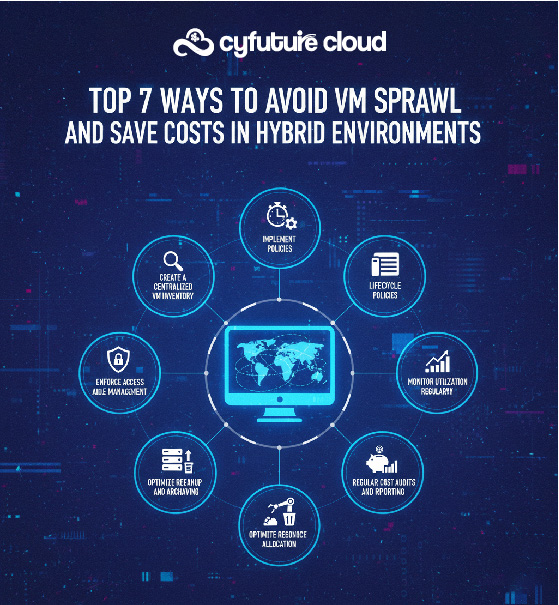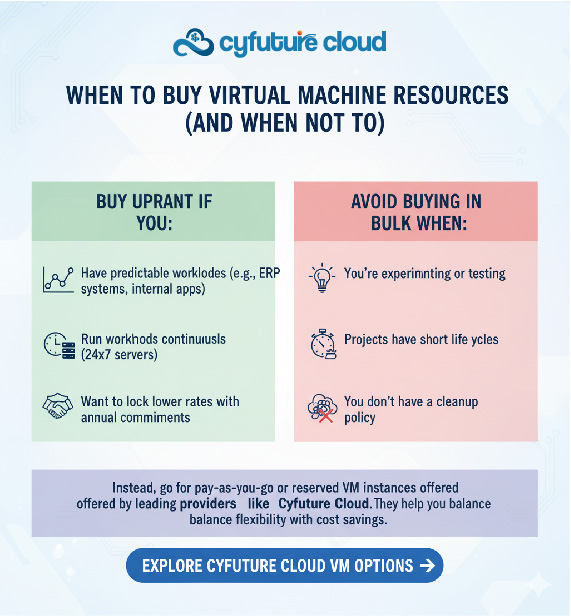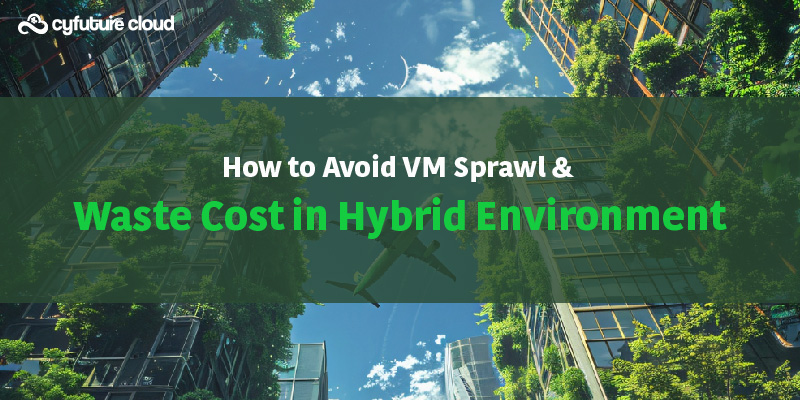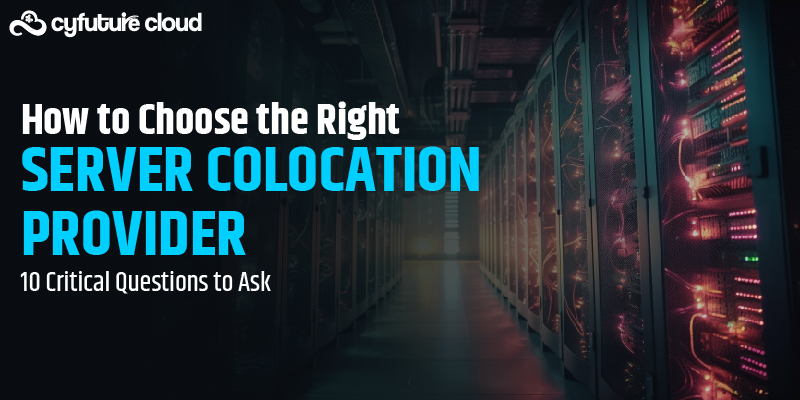Get 69% Off on Cloud Hosting : Claim Your Offer Now!
- Products
-
Compute
Compute
- Predefined TemplatesChoose from a library of predefined templates to deploy virtual machines!
- Custom TemplatesUse Cyfuture Cloud custom templates to create new VMs in a cloud computing environment
- Spot Machines/ Machines on Flex ModelAffordable compute instances suitable for batch jobs and fault-tolerant workloads.
- Shielded ComputingProtect enterprise workloads from threats like remote attacks, privilege escalation, and malicious insiders with Shielded Computing
- GPU CloudGet access to graphics processing units (GPUs) through a Cyfuture cloud infrastructure
- vAppsHost applications and services, or create a test or development environment with Cyfuture Cloud vApps, powered by VMware
- Serverless ComputingNo need to worry about provisioning or managing servers, switch to Serverless Computing with Cyfuture Cloud
- HPCHigh-Performance Computing
- BaremetalBare metal refers to a type of cloud computing service that provides access to dedicated physical servers, rather than virtualized servers.
-
Storage
Storage
- Standard StorageGet access to low-latency access to data and a high level of reliability with Cyfuture Cloud standard storage service
- Nearline StorageStore data at a lower cost without compromising on the level of availability with Nearline
- Coldline StorageStore infrequently used data at low cost with Cyfuture Cloud coldline storage
- Archival StorageStore data in a long-term, durable manner with Cyfuture Cloud archival storage service
-
Database
Database
- MS SQLStore and manage a wide range of applications with Cyfuture Cloud MS SQL
- MariaDBStore and manage data with the cloud with enhanced speed and reliability
- MongoDBNow, store and manage large amounts of data in the cloud with Cyfuture Cloud MongoDB
- Redis CacheStore and retrieve large amounts of data quickly with Cyfuture Cloud Redis Cache
-
Automation
Automation
-
Containers
Containers
- KubernetesNow deploy and manage your applications more efficiently and effectively with the Cyfuture Cloud Kubernetes service
- MicroservicesDesign a cloud application that is multilingual, easily scalable, easy to maintain and deploy, highly available, and minimizes failures using Cyfuture Cloud microservices
-
Operations
Operations
- Real-time Monitoring & Logging ServicesMonitor & track the performance of your applications with real-time monitoring & logging services offered by Cyfuture Cloud
- Infra-maintenance & OptimizationEnsure that your organization is functioning properly with Cyfuture Cloud
- Application Performance ServiceOptimize the performance of your applications over cloud with us
- Database Performance ServiceOptimize the performance of databases over the cloud with us
- Security Managed ServiceProtect your systems and data from security threats with us!
- Back-up As a ServiceStore and manage backups of data in the cloud with Cyfuture Cloud Backup as a Service
- Data Back-up & RestoreStore and manage backups of your data in the cloud with us
- Remote Back-upStore and manage backups in the cloud with remote backup service with Cyfuture Cloud
- Disaster RecoveryStore copies of your data and applications in the cloud and use them to recover in the event of a disaster with the disaster recovery service offered by us
-
Networking
Networking
- Load BalancerEnsure that applications deployed across cloud environments are available, secure, and responsive with an easy, modern approach to load balancing
- Virtual Data CenterNo need to build and maintain a physical data center. It’s time for the virtual data center
- Private LinkPrivate Link is a service offered by Cyfuture Cloud that enables businesses to securely connect their on-premises network to Cyfuture Cloud's network over a private network connection
- Private CircuitGain a high level of security and privacy with private circuits
- VPN GatewaySecurely connect your on-premises network to our network over the internet with VPN Gateway
- CDNGet high availability and performance by distributing the service spatially relative to end users with CDN
-
Media
-
Analytics
Analytics
-
Security
Security
-
Network Firewall
- DNATTranslate destination IP address when connecting from public IP address to a private IP address with DNAT
- SNATWith SNAT, allow traffic from a private network to go to the internet
- WAFProtect your applications from any malicious activity with Cyfuture Cloud WAF service
- DDoSSave your organization from DoSS attacks with Cyfuture Cloud
- IPS/ IDSMonitor and prevent your cloud-based network & infrastructure with IPS/ IDS service by Cyfuture Cloud
- Anti-Virus & Anti-MalwareProtect your cloud-based network & infrastructure with antivirus and antimalware services by Cyfuture Cloud
- Threat EmulationTest the effectiveness of cloud security system with Cyfuture Cloud threat emulation service
- SIEM & SOARMonitor and respond to security threats with SIEM & SOAR services offered by Cyfuture Cloud
- Multi-Factor AuthenticationNow provide an additional layer of security to prevent unauthorized users from accessing your cloud account, even when the password has been stolen!
- SSLSecure data transmission over web browsers with SSL service offered by Cyfuture Cloud
- Threat Detection/ Zero DayThreat detection and zero-day protection are security features that are offered by Cyfuture Cloud as a part of its security offerings
- Vulnerability AssesmentIdentify and analyze vulnerabilities and weaknesses with the Vulnerability Assessment service offered by Cyfuture Cloud
- Penetration TestingIdentify and analyze vulnerabilities and weaknesses with the Penetration Testing service offered by Cyfuture Cloud
- Cloud Key ManagementSecure storage, management, and use of cryptographic keys within a cloud environment with Cloud Key Management
- Cloud Security Posture Management serviceWith Cyfuture Cloud, you get continuous cloud security improvements and adaptations to reduce the chances of successful attacks
- Managed HSMProtect sensitive data and meet regulatory requirements for secure data storage and processing.
- Zero TrustEnsure complete security of network connections and devices over the cloud with Zero Trust Service
- IdentityManage and control access to their network resources and applications for your business with Identity service by Cyfuture Cloud
-
-
Compute
- Solutions
-
Solutions
Solutions
-
 Cloud
Hosting
Cloud
Hosting
-
 VPS
Hosting
VPS
Hosting
-
GPU Cloud
-
 Dedicated
Server
Dedicated
Server
-
 Server
Colocation
Server
Colocation
-
 Backup as a Service
Backup as a Service
-
 CDN
Network
CDN
Network
-
 Window
Cloud Hosting
Window
Cloud Hosting
-
 Linux
Cloud Hosting
Linux
Cloud Hosting
-
Managed Cloud Service
-
Storage as a Service
-
 VMware
Public Cloud
VMware
Public Cloud
-
 Multi-Cloud
Hosting
Multi-Cloud
Hosting
-
 Cloud
Server Hosting
Cloud
Server Hosting
-
 Bare
Metal Server
Bare
Metal Server
-
 Virtual
Machine
Virtual
Machine
-
 Magento
Hosting
Magento
Hosting
-
Remote Backup
-
 DevOps
DevOps
-
 Kubernetes
Kubernetes
-
 Cloud
Storage
Cloud
Storage
-
NVMe Hosting
-
 DR
as s Service
DR
as s Service
-
-
Solutions
- Marketplace
- Pricing
- Resources
- Resources
-
By Product
Use Cases
-
By Industry
- Company
-
Company
Company
-
Company
How to Avoid VM Sprawl & Waste Cost in Hybrid Environment
Table of Contents
- What is VM Sprawl?
- The Real Cost of VM Sprawl
- 7 Ways to Prevent VM Sprawl & Cut Hybrid Cloud Costs
- When to Buy Virtual Machine Resources (and When Not To)
- How to Estimate Your Virtual Machine Cost
- The Hidden Cost: Security and Compliance
- Integrating with Hybrid Cloud Strategy
- Conclusion: Optimize, Don’t Overbuild
Did you know over 20% of enterprise IT budgets are wasted each year due to unmanaged virtual machines and idle cloud instances?
This silent budget leak called VM Sprawl is one of the biggest challenges organizations face in today’s hybrid cloud environments.
From startups testing multiple builds to large enterprises scaling fast, virtual machines (VMs) are everywhere. They promise agility and cost efficiency but when left unchecked, they can quietly inflate costs, degrade performance, and create unnecessary complexity.
In this blog, we’ll explore how to avoid VM sprawl and control your virtual machine cost, how much RAM, CPU, and storage you really need, and how to pick the right virtual machine options before you buy.
What is VM Sprawl?
VM Sprawl occurs when an organization creates too many virtual machines without proper tracking or lifecycle management.
Over time, these forgotten or underutilized VMs consume compute resources, storage, and licenses, leading to performance drops and rising bills.
In a hybrid environment—where workloads are split between on-premises servers and cloud hosting platforms like AWS cloud, Azure, or Cyfuture Cloud—this problem magnifies. Teams spin up VMs for testing, deployment, or client demos, but rarely decommission them after use.
Result:
You pay for compute power you’re not using, while performance across active workloads suffers.

The Real Cost of VM Sprawl
According to Gartner, unused virtual machines can inflate cloud bills by 30–35% annually.
For mid-sized Indian businesses, that’s ₹10–₹20 lakhs lost per year—just because of idle VMs and duplicate environments.
The impact isn’t just financial:
- System performance declines due to overutilized hosts.
- Backup and storage systems slow down.
- Security risks increase when outdated VMs remain online.
- Teams waste time identifying and cleaning up legacy machines.
To put it simply—VM sprawl quietly drains your IT efficiency and ROI.

7 Ways to Prevent VM Sprawl & Cut Hybrid Cloud Costs
Let’s make it actionable.
Here are seven proven, evergreen methods to prevent VM sprawl and optimize costs—whether you’re managing on-prem, cloud, or hybrid virtual machines.
1. Create a Centralized VM Inventory
The first step to control sprawl is visibility.
Maintain a unified inventory of all VMs—across data centers and cloud providers. Use management tools like:
- VMware vCenter
- Microsoft System Center
- Cyfuture Cloud Console
This helps you track:
- Who created the VM
- When it was created
- Purpose, OS type, and usage pattern
Pro tip: Automate tagging (like “Dev”, “Test”, “Prod”) so you can easily identify idle or outdated machines.
2. Implement Lifecycle Policies
Every VM should have a defined life span.
For instance:
- Test environments: auto-expire after 30 days
- Client demo VMs: delete 7 days after handover
- Project VMs: review after every sprint
This prevents accumulation of outdated systems and reduces your virtual machine cost over time.
3. Monitor Utilization Metrics Regularly
Set up automated monitoring for CPU, RAM, and disk I/O.
If a VM runs below 10% utilization for more than a week—consider shutting it down or consolidating workloads.
Tools like Prometheus, vRealize Operations, or Cyfuture Cloud Monitor can help track this easily.
4. Automate Cleanup and Archiving
Leverage scripts or policies that automatically delete unused VMs after a set period of inactivity.
Alternatively, archive snapshots to cheaper storage tiers.
This ensures your high-performance hosts remain free for active workloads.
5. Optimize Resource Allocation
Here’s where performance meets cost control.
Over provisioning (assigning too much CPU/RAM) is just as wasteful as sprawl.
How Much RAM, CPU, and Storage Do You Really Need for a Virtual Machine?
It depends on your workload:
|
Workload Type |
CPU |
RAM |
Storage |
|
Lightweight App / Web Server |
1–2 vCPU |
2–4 GB |
40–80 GB SSD |
|
Development / Testing |
2–4 vCPU |
4–8 GB |
100–200 GB SSD |
|
Database / Analytics |
4–8 vCPU |
8–32 GB |
200–500 GB SSD |
|
Machine Learning / GPU tasks |
8+ vCPU / GPU cores |
32+ GB |
500 GB+ NVMe |
For hybrid setups, consider auto-scaling and resource pooling so you pay only for what’s used.
Keyword Insight: When you buy virtual machine instances, check for providers offering flexible resource scaling—so you never overpay for unused capacity.
6. Regular Cost Audits and Reporting
Schedule monthly or quarterly audits to analyze:
- Idle VMs
- Over-provisioned VMs
- Unused licenses
- Backup storage bloat
Modern platforms like Cyfuture Cloud, AWS Cost Explorer, or Azure cloud Cost Management provide detailed usage insights to help you right-size and save up to 25–30% on operational costs.
7. Enforce Access Control and Role Management
Unrestricted VM creation is a root cause of sprawl. Limit provisioning rights to authorized personnel. Use Role-Based Access Control (RBAC) to ensure developers or testers can’t deploy VMs without approval.
This prevents unnecessary instances from cluttering your environment—and helps maintain security.

When to Buy Virtual Machine Resources (and When Not To)
Buying virtual machine resources upfront can be cost-efficient if you:
- Have predictable workloads (e.g., ERP systems, internal apps)
- Run workloads continuously (24×7 servers)
- Want to lock lower rates with annual commitments
Avoid buying VMs in bulk when:
- You’re experimenting or testing
- Projects have short life cycles
- You don’t have a cleanup policy
Instead, go for pay-as-you-go or reserved VM instances offered by leading providers like Cyfuture Cloud.
They help you balance flexibility with cost savings.
How to Estimate Your Virtual Machine Cost
Here’s a simple formula:
VM Cost = (vCPU hours × rate) + (RAM GB hours × rate) + (Storage GB × monthly rate)
Example:
A 4 vCPU, 8 GB RAM, 100 GB SSD VM running 24×7 for a month may cost around:
- ₹4,000–₹6,000 on-premises
- ₹6,000–₹9,000 on premium cloud
- ₹5,000–₹7,000 on cost-efficient providers like Cyfuture Cloud
Pro tip: Always compare virtual machine options—CPU type, storage performance, and data transfer costs—before finalizing a plan.
The Hidden Cost: Security and Compliance
Unused VMs aren’t just a cost issue—they’re a security risk.
Each inactive VM can:
- Miss patch updates
- Expose outdated OS vulnerabilities
- Retain sensitive data
This makes VM sprawl not only expensive but also risky in regulated sectors like banking, healthcare, and ecommerce.
Enforce:
- Regular patching
- Vulnerability scans
- Auto-shutdown for inactive VMs
A secure, well-governed VM environment is the foundation of sustainable hybrid infrastructure.
Integrating with Hybrid Cloud Strategy
In 2025, most Indian enterprises are hybrid by design—using both on-premises virtual machines and cloud-based VMs.
To make this work seamlessly:
- Use a unified management dashboard
- Enable VM mobility (migrate VMs easily between environments)
- Integrate backup and Disaster Recovery systems across clouds
- Maintain consistent security policies
This ensures flexibility without duplication—and reduces the risk of forgotten or shadow VMs.

Conclusion: Optimize, Don’t Overbuild
Virtual Machines are the backbone of modern IT—but without proper governance, they can quickly become a liability.
The key is balance:
- Deploy what you need
- Monitor continuously
- Decommission proactively
By implementing these 7 steps, you’ll not only avoid VM sprawl but also save 20–30% of your virtual machine cost annually, improve security posture, and enhance hybrid cloud performance.
Recent Post

Stay Ahead of the Curve.
Join the Cloud Movement, today!
© Cyfuture, All rights reserved.
Send this to a friend

 Pricing
Calculator
Pricing
Calculator
 Power
Power
 Utilities
Utilities VMware
Private Cloud
VMware
Private Cloud VMware
on AWS
VMware
on AWS VMware
on Azure
VMware
on Azure Service
Level Agreement
Service
Level Agreement 


















